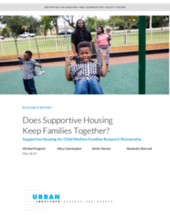Executive Summary
In 2012, the Children’s Bureau in the US Department of Health and Human Services’ Administration for Children and Families funded Partnerships to Demonstrate the Effectiveness of Supportive Housing for Families in the Child Welfare System, a five-year, $25 million demonstration that provided supportive housing to families in the child welfare system, in five sites:
- Housing, Empowerment, Achievement, Recovery, and Triumph Alliance for Sustainable Families—Broward County, Florida
- Partners United for Supportive Housing in Cedar Rapids—Cedar Rapids, Iowa
- Intensive Supportive Housing for Families—Connecticut
- Memphis Strong Families Initiative—Memphis, Tennessee
- Families Moving Forward—San Francisco, California
With funding from the Robert Wood Johnson Foundation, the Annie E. Casey Foundation, Casey Family Programs, and the Edna McConnell Clark Foundation, the Urban Institute conducted the crosssite evaluation, a mixed-methods randomized controlled trial that included 807 families, who were randomized to either a treatment group (N = 377) or a control group (N = 430). To understand the program’s impact, we drew upon four data sources: child welfare administrative data, program referral data, data on housing assistance for the treatment group, and family surveys conducted at baseline and 12 months after randomization. The study launched in 2012 and concluded in December 2018. This report provides our findings from the impact analysis. Our research focused on answering the following: Does supportive housing improve access to services, keep families stably housed, help keep families together and reduce their time spent in the child welfare system, and improve the health and social and emotional well-being for parents and children?
This demonstration showed that supportive housing can improve families’ lives. With subsidized housing, families become more stable. Some sites were able to keep children with their parents and reduce families’ involvement with the child welfare system. Although not consistent across sites, the positive impact in some sites shows that supportive housing can be successful. Our study finds mixed results on parent, child, and family well-being one year after program enrollment. We are continuing to track these outcomes, capturing outcomes at four and a half years after enrollment.

